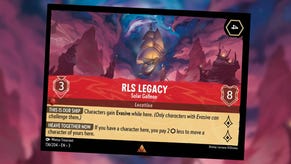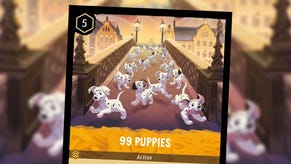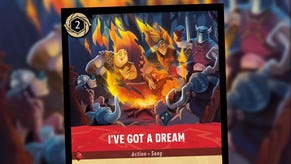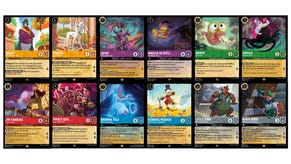Disney Lorcana’s gameplay has potential but its starter set lacks a clear identity – hands-on preview
Can it go the distance?
We were able to play Disney Lorcana for the very first time via a demo with co-designer Ryan Miller at last weekend’s UK Games Expo 2023.
Disney Lorcana is a trading card game that has the potential to challenge even TCG titans such as Magic: The Gathering and Pokémon, largely due to the fact that it has the backing of one of the largest corporations in the world. While it was a given that Disney Lorcana would have an advantage thanks to inclusion of the likes of characters and references such as Mickey Mouse, Sleeping Beauty, Frozen, Moana and more, whether the game would be any good was yet to be seen.
Though the time we spent with Disney Lorcana was not nearly enough for a full review, it was enough to give us a baseline of the game’s potential.
Disney Lorcana sees at least two players competing against one another to be the first to gather 20 lore. Players can collect lore in a variety of ways, with the main one being to send their active character cards questing - which will see them obtaining a certain amount of lore, depending on the specific card.
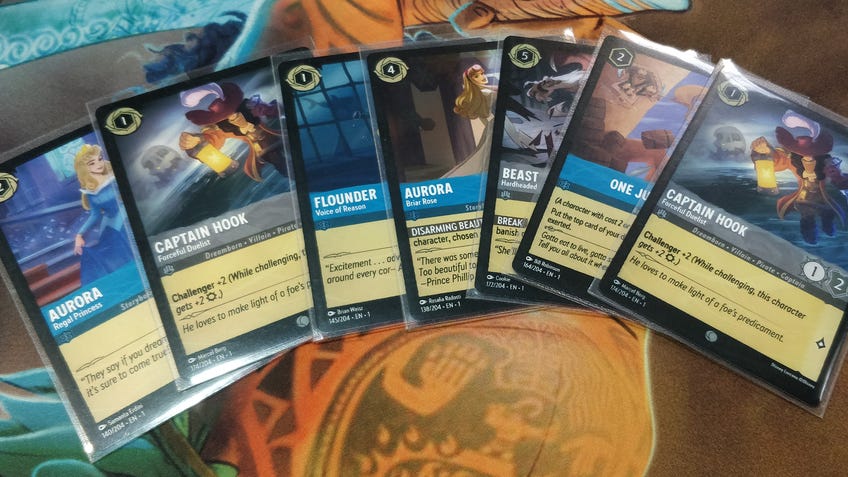
Players will need to spend the in-game resource of ink to play cards, but unlike Magic: The Gathering’s mana and energy in the Pokémon TCG, players will not need to worry about needing to use specific types of ink in Lorcana. Rather, every single card in the game can be turned into exactly one use of ink if it’s placed in their inkwell – a separate space for players to put cards facedown. While players can only do this once per turn, it means that they will not need to wait to draw specific cards in order to get their other cards out onto the table. Players can also use any ink they’ve put into their inkwell immediately, rather than having to wait until their next turn.
While character cards can’t be used the turn they’re played – because their ink is still wet – they can be sent on a quest when the player’s next turn rolls around. However, questing with a character card leaves them vulnerable to being challenged, which is when a player pits one of their cards against one of their opponent’s. Like Magic: The Gathering’s combat or the Pokémon TCG’s battles, challenging sees the two cards involved having their strength and health compared, with damage being exchanged based on the difference between the two. As damage is carried over turns, players will need to think carefully about who to send questing and who to challenge.
The majority of character cards in my deck were very simple, with one or two exceptions.
The two decks we played with at the UKGE 2023 demo were pared-down versions of the Sleeping Beauty/Simba and Mickey Mouse/Moana decks that will be sold as part of the starter sets at Disney Lorcana’s launch this summer. Rather than playing until someone reaches 20 lore, the goal of this demo game was to reach 10 lore. Though it was a short, single playthrough, and therefore not necessarily enough time to see these individual gameplay mechanics play out, the decks didn’t feel distinctly unique.
The starter decks for Disney Lorcana seem to be focused on getting players who are entirely new to trading card games on board with the game as a whole, rather than providing vastly unique deck experiences. Nevertheless, there were some gameplay mechanics that did feel compelling, namely those crucial to the trading card game’s core. Being able to start playing cards as quickly as I was able to get ink in my inkwell felt satisfying. Rather than fretting over whether I’d be able to even get any cards on the board, I was able to almost immediately start thinking about which cards I wanted to get out next and what I wanted to do with them.
The majority of character cards in my deck were very simple, with one or two exceptions - such as Hei Hei, the chicken from Moana who could provide support to my other characters whenever he went questing, or Tangled’s Pascal, whose evasive nature meant that they could not be challenged unless the opposing character was also evasive.
Otherwise, many of my characters simply had stats that would enable them to either be a threat to the opposing questing characters, or could withstand a challenge whenever they went questing themselves. I also had access to a few song cards, which are instant spells that can be played by spending ink or by using a character card that costs a certain amount of ink to be play. Using The Princess and the Frog’s Friends on the Other Side song – which can be actively sung by the player when used, if they so wish to – I was able to draw two additional cards, thereby maintaining the already speedy momentum I had built up and helping me win the game.

Moments like this were where the deck’s specific gameplay mechanics were most prevalent and, funnily enough, where I was having the most fun. Considering its target audience, it makes a lot of sense for the starter decks for Disney Lorcana to prioritise teaching the basic gameplay mechanics over anything else, but it didn't make playing them feel any less underwhelming.
Whilst it would be unwise to overcomplicate Disney Lorcana’s gameplay from the off, the sample decks we used played things much too safe.
Even though the deck I used was a smaller version of the planned Mickey Mouse/Moana starter deck – with just 40 cards, instead of the standard 60 – there were multiple copies of cards that never felt like they could radically change the course of a game. Whilst it would be unwise to overcomplicate Disney Lorcana’s gameplay from the off, the sample decks we used played things much too safe. After all, you can still have simple yet bombastic plays, but these decks had none of those.
As someone who has dabbled in Magic: The Gathering, but is far from a seasoned player, Disney Lorcana felt incredibly simple by comparison, though not quite as barebones as the Pokémon TCG can sometimes feel. I’m just hoping that some of the sets they bring out in the future step things up and show us what Disney Lorcana’s core gameplay mechanics can really do that’s special.



